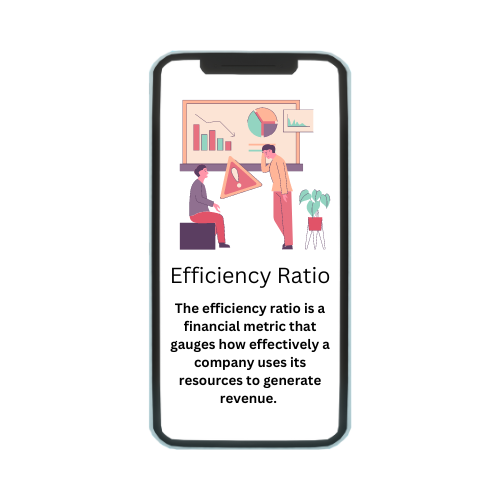The efficiency ratio is a crucial financial metric that evaluates how well a company utilizes its resources to generate income, reflecting its operational performance and financial health. This ratio measures the relationship between a company’s inputs, such as assets and expenses, and its outputs, like revenue and profit. Understanding and analyzing the efficiency ratio is vital for various stakeholders, including investors and financial analysts, as it provides insights into a company’s effectiveness in managing its operations. A lower efficiency ratio generally indicates that a company is operating efficiently, using fewer resources to generate higher income, which is often a sign of good management and strong financial performance. Conversely, a higher efficiency ratio may point to inefficiencies and potential areas for improvement. This metric is indispensable for making informed investment decisions, as it helps identify companies with robust operational practices and growth potential. However, it’s essential to consider the limitations and industry-specific benchmarks when interpreting efficiency ratios to avoid misleading conclusions.
What Is The Efficiency Ratio?
The efficiency ratio is a financial metric that gauges how effectively a company uses its resources to generate revenue. It is particularly significant in evaluating the performance of a company’s core operations by comparing its operating expenses to its net sales. Essentially, this ratio highlights the proportion of revenue that is consumed by operating costs, providing a clear picture of operational efficiency. The lower the efficiency ratio, the better, as it indicates that a company is able to generate more income while keeping its operational costs low. This metric is widely used by investors, financial analysts, and management to assess and compare the efficiency of different companies within the same industry. It helps in identifying strengths and weaknesses in a company’s operational practices, guiding strategic decisions and investments. However, it’s important to consider that this ratio should be analyzed in conjunction with other financial metrics and industry standards to obtain a comprehensive understanding of a company’s performance.
Why Is The Efficiency Ratio Important?
The efficiency ratio is important because it provides a clear measure of how well a company is managing its resources to generate profits. By comparing operating expenses to net sales, this ratio offers insights into the effectiveness of a company’s operational management. A lower efficiency ratio signifies that the company is efficient in controlling its costs relative to its revenue, which is a positive indicator for investors and stakeholders. This metric is crucial for making informed investment decisions, as it helps identify companies that are capable of maximizing their profits with minimal costs. Additionally, the efficiency ratio can highlight areas where a company may need to improve its operations, offering guidance for management to enhance performance and competitiveness. Overall, the efficiency ratio is a key indicator of a company’s financial health and operational success, making it an essential tool for anyone involved in financial analysis and decision-making.
Types Of Efficiency Ratios
Efficiency ratios come in various forms, each highlighting different aspects of a company’s operational performance. Here are some key types:
- Operating Efficiency Ratio: Measures a company’s ability to convert operational activities into sales. A lower ratio indicates better efficiency in managing operational expenses.
- Asset Turnover Ratio: Evaluates how effectively a company uses its assets to generate sales. Calculated by dividing net sales by average total assets, a higher ratio signifies greater efficiency.
- Inventory Turnover Ratio: Assesses how quickly a company sells and replaces its inventory. This ratio is calculated by dividing the cost of goods sold by the average inventory. A high turnover ratio suggests efficient inventory management.
- Receivables Turnover Ratio: Indicates how efficiently a company collects revenue from its customers. It is calculated by dividing net credit sales by average accounts receivable. A higher ratio means the company is effective in managing its credit policies and collections.
How Is The Efficiency Ratio Calculated?
The efficiency ratio is calculated by dividing a company’s operating expenses by its net sales. The formula is straightforward:
Efficiency Ratio = Operating Expenses / Net Sales
To calculate this ratio, start by gathering the necessary financial data from the company’s income statement, specifically the total operating expenses and net sales figures. Next, divide the operating expenses by the net sales to determine the ratio. This calculation provides a percentage that represents the proportion of revenue consumed by operating costs. For example, if a company has operating expenses of $500,000 and net sales of $2,000,000, the efficiency ratio would be:
Efficiency Ratio = 500,000 / 2,000,000 = 0.25
This means that 25% of the company’s revenue is used to cover operating expenses. A lower efficiency ratio is preferable as it indicates that the company is using its resources more effectively to generate income. This metric is crucial for comparing the efficiency of different companies, especially within the same industry, and for identifying potential areas for cost reduction and operational improvement.
Examples with Calculations
Understanding the efficiency ratio becomes clearer with concrete examples and calculations. Let’s consider two hypothetical companies, Company A and Company B, to illustrate this.
Company A has operating expenses of $600,000 and net sales of $3,000,000. To calculate the efficiency ratio for Company A, we use the formula:
Efficiency Ratio = Operating Expenses / Net Sales
Plugging in the numbers:
Efficiency Ratio = 600,000 / 3,000,000 = 0.20
This means Company A uses 20% of its revenue to cover operating expenses, indicating a relatively efficient use of resources.
Company B, on the other hand, has operating expenses of $800,000 and net sales of $2,500,000. Applying the same formula:
Efficiency Ratio = 800,000 / 2,500,000 = 0.32
This shows that Company B uses 32% of its revenue for operating expenses, which is less efficient compared to Company A.
From these examples, we can see that Company A is more efficient in managing its operating expenses relative to its revenue, as reflected by its lower efficiency ratio of 0.20 compared to Company B’s 0.32. These calculations help stakeholders assess and compare the operational efficiency of different companies, guiding better financial and investment decisions.
Efficiency Ratio Impact On Investor Decisions
The efficiency ratio significantly impacts investor decisions as it provides insight into a company’s operational efficiency and financial health. Investors use this ratio to evaluate how well a company is managing its resources to generate income. A lower efficiency ratio indicates that the company is effectively controlling its operating expenses relative to its revenue, which is a positive sign for investors. It suggests that the company has strong management practices and a solid operational foundation, making it a potentially profitable investment. Conversely, a higher efficiency ratio may raise red flags, indicating that the company is spending a larger portion of its revenue on operating costs, which can lead to reduced profitability. This can deter investors, as it suggests inefficiencies and potential financial instability. By analyzing the efficiency ratio alongside other financial metrics, investors can make more informed decisions, choosing to invest in companies with better operational performance and higher potential for growth and returns.
Factors Affecting The Efficiency Ratio
Several factors can influence a company’s efficiency ratio, impacting its operational efficiency and financial performance. Here are key factors to consider:
- Management Practices: Effective leadership and strategic decision-making can enhance efficiency by optimizing resource allocation and reducing unnecessary expenses.
- Operational Processes: Streamlined and efficient processes can lower operating costs and improve the efficiency ratio. Inefficient processes can lead to higher expenses and a worse ratio.
- Technological Advancements: Implementing advanced technology can automate tasks, reduce errors, and enhance productivity, positively affecting the efficiency ratio.
- Economic Conditions: Economic downturns can increase costs and reduce sales, negatively impacting the efficiency ratio. Conversely, a strong economy can improve it.
- Market Competition: High competition may drive companies to operate more efficiently to maintain profitability and market share, thus improving their efficiency ratios.
- Industry Standards: Different industries have varying benchmarks for efficiency ratios. Companies need to consider their industry norms when evaluating their performance.
- Scale of Operations: Larger companies might achieve economies of scale, reducing per-unit costs and improving the efficiency ratio. Smaller companies might struggle with higher per-unit costs.
- Regulatory Environment: Regulatory requirements can impose additional costs, affecting the efficiency ratio. Companies operating in heavily regulated industries may face higher operational expenses.
Limitations Of The Efficiency Ratio
The efficiency ratio, while a useful metric, has several limitations that should be considered when interpreting its results:
- Doesn’t Consider Quality: The efficiency ratio focuses on the relationship between expenses and revenue but does not account for the quality of products or services produced. A company might have a low efficiency ratio but still deliver high-quality products, which could impact customer satisfaction and long-term profitability.
- Seasonal Variations: Certain industries may experience seasonal fluctuations in sales and expenses, which can distort the efficiency ratio. For example, retail companies often have higher sales and expenses during the holiday season, affecting their efficiency ratio for that period.
- Industry Variances: Different industries have varying operational standards and cost structures. Comparing efficiency ratios across industries may not provide an accurate benchmark due to these differences.
- Non-Operating Items: Items such as one-time expenses, non-operating income, or gains/losses from investments can distort the efficiency ratio. These items are not reflective of the company’s core operations but can impact the ratio calculations.
- Dependence on Accounting Methods: The efficiency ratio relies on accounting data, which can be subject to manipulation or errors. Different accounting methods or principles used by companies can affect the calculation and comparability of efficiency ratios.
- Inflation and Price Changes: Inflation or changes in pricing can impact expenses and revenue differently, influencing the efficiency ratio. Companies may adjust prices to maintain profitability, affecting the ratio’s accuracy.
- Lack of Industry Specificity: While the efficiency ratio is valuable for intra-industry comparisons, it may not account for specific nuances or operational differences within industries, limiting its usefulness for certain analyses.
Conclusion
In conclusion, the efficiency ratio serves as a critical metric for evaluating a company’s operational performance and financial health. It provides valuable insights into how effectively a company utilizes its resources to generate revenue, with a lower ratio generally indicating better efficiency. Investors and stakeholders use the efficiency ratio to make informed decisions about investment opportunities, as it helps identify companies with strong management practices and potential for growth. However, it’s important to recognize the limitations of the efficiency ratio, such as its inability to account for quality factors, seasonal variations, and industry-specific differences. Therefore, while the efficiency ratio is a useful tool, it should be used in conjunction with other financial metrics and qualitative assessments to gain a comprehensive understanding of a company’s overall performance and sustainability.
fREQUENTLY ASKED QUESTIONS(FAQs)
A good efficiency ratio varies by industry but generally, a lower ratio indicates better efficiency.
Companies can improve their efficiency ratio by optimizing their operations, reducing waste, and enhancing management practices.
The efficiency ratio should be calculated regularly, typically quarterly or annually, to monitor performance over time.
Comparing efficiency ratios across different industries can be misleading due to varying operational standards and benchmarks.
Common pitfalls include not considering industry differences, seasonal variations, and the overall quality of operations.






